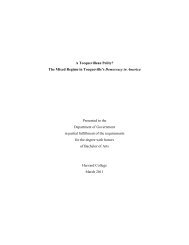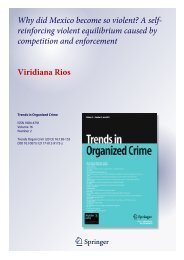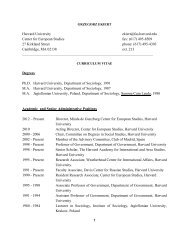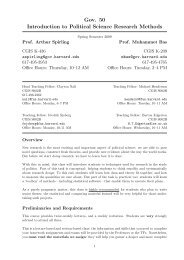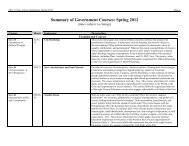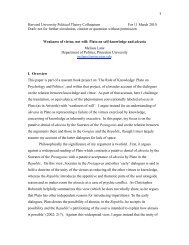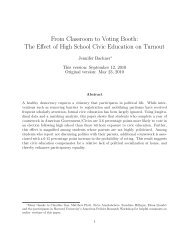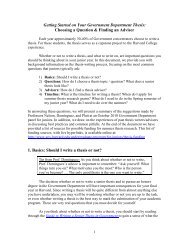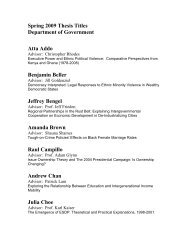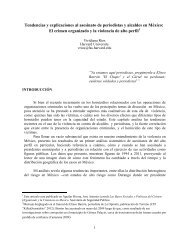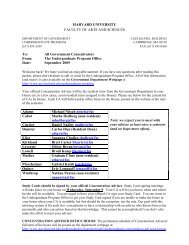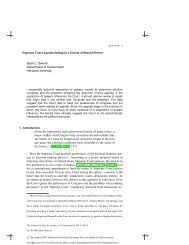Security issues and immigration flows: Drug-violence refugees, the ...
Security issues and immigration flows: Drug-violence refugees, the ...
Security issues and immigration flows: Drug-violence refugees, the ...
You also want an ePaper? Increase the reach of your titles
YUMPU automatically turns print PDFs into web optimized ePapers that Google loves.
are significant in all out<strong>flows</strong> specifications. An increase of one point in employment rates<br />
or in <strong>the</strong> number of college degrees per 100,000 inhabitants reduces migration out<strong>flows</strong> in<br />
0.01 <strong>and</strong> 0.11 per 100,000 inhabitants, respectively. Nei<strong>the</strong>r employment, nor education<br />
are significantly correlated with migration in<strong>flows</strong>. In o<strong>the</strong>r words, when deciding where<br />
to relocate, Mexicans do not go to cities with higher levels of education or lower unemployment.<br />
Finally, all variables introduced to correct for CONAPO’s error were strongly significant.<br />
Indeed, it seems like CONAPO faces inherent problems in measuring population<br />
<strong>flows</strong> in some places more than o<strong>the</strong>rs. In general, places where CONAPO’s 2005 predictions<br />
were upward biased (i.e. CONAPO predicted more people than <strong>the</strong> 2005 census)<br />
had <strong>the</strong> same upper bias in 2010. The relationship is 1 to 0.77 in <strong>the</strong> preferred specification,<br />
meaning an error of 1 in 2005 figures is correlated with an error of 0.77 in 2010 figures 6<br />
The new driver of Mexico’s <strong>immigration</strong> <strong>flows</strong>: security<br />
<strong>issues</strong>.<br />
“I know that we came here illegally, but at least we can sleep in peace now”<br />
Citizen of Juarez relocated at El Paso (Torres, 2011)<br />
The effect of <strong>violence</strong> in determining migration out<strong>flows</strong> is a well-studied phenomenon<br />
within political science research of Africa <strong>and</strong> o<strong>the</strong>r civil-war contexts (Zolberg et al,<br />
1989; Morrison, 1993). Most of <strong>the</strong>se studies emphasize <strong>the</strong> role of <strong>violence</strong> in generating<br />
6 The fact that drug-related <strong>violence</strong> is predictor or unexpected migration out<strong>flows</strong> is a particularly<br />
robust finding even more, if we consider that CONAPO’s 2010 population predictions assumed migration<br />
<strong>flows</strong> to <strong>the</strong> US will remain at least as high as those measured in 2000, which now we know, is <strong>the</strong> highest<br />
point of Mexico-US migration up to date (MPP, 2009). Given unexpectedly harsh economic conditions in<br />
<strong>the</strong> US, particularly 2007 <strong>and</strong> 2008, CONAPO’s should result in an upper bias. In o<strong>the</strong>r words, CONAPO<br />
assumed US labor markets will remain as appealing for Mexicans as <strong>the</strong>y were in 2000, which clearly<br />
was not <strong>the</strong> case. The fact that, even with CONAPO’s upper estimation bias, migration figures were<br />
underestimated in border towns strongly reinforces my hypo<strong>the</strong>sis that o<strong>the</strong>r factors, not economical, are<br />
driving migration decisions.<br />
14



